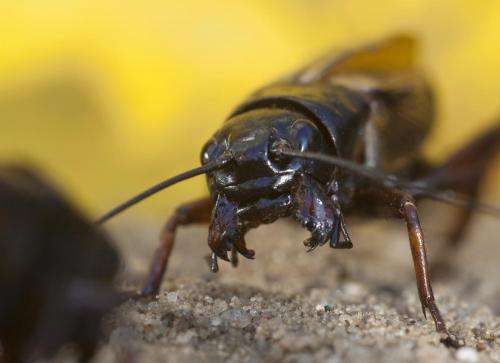March 16, 2015 report
Research pair find nitric oxide governs fight-or-flight response in crickets (w/ video)

(Phys.org)—A pair of researchers working in Germany has found that the chemical nitric oxide has a profound impact on the fight-or-flight response of fighting crickets. In their paper published in the journal Science Advances, Paul Stevenson and Jan Rillich describe experiments they conducted with crickets and nitric oxide, what they observed and their conclusions.
The fight-or-flight response is well documented in a wide variety of mammals, including humans. It has also been found in insects. Still, how it works exactly continues to be a mystery. Suspecting it might have to do with brain chemicals, Stevenson and Rillich focused on one brain chemical in particular: nitric oxide. It has been shown to speed up snails and to impact behavior in other animals. To find out if it might have an impact on the flight-or-flight response, the team decided to test its impact on Mediterranean field crickets, which are well known for their animated brawls.
Prior research has shown that when fighting, nitric oxide is generated in the brains of the crickets, though its purpose has been a mystery. To learn more, the researchers put test crickets in a box and filmed them as they grew aggressive and fought and continued filming until one or the other of the crickets gave up and ran away. To test the impact of nitric oxide on the crickets, the researchers conducted experiments where one or both had more or less of the chemical introduced artificially into their brains, and then watched to see how it impacted their behavior. They found that adding more of the chemical tended to switch on the flight mechanism—the cricket would stop fighting and run away, and would continue to cow before the other cricket until the chemical was naturally washed out of its system (or was blocked artificially by the researchers). Conversely, they found that restricting the chemical tended to cause the crickets to be even more aggressive and to keep on fighting longer.
It is not known of course if the same response might occur in mammals, particularly humans, but the idea is interesting—perhaps someday soon, instead of tossing teargas into rioting crowds, police officers can instead toss nitric oxide bombs that will cause everyone to give up the cause and run home.
More information: Adding up the odds—Nitric oxide signaling underlies the decision to flee and post-conflict depression of aggression, Science Advances 13 Mar 2015: Vol. 1 no. 2 e1500060 DOI: 10.1126/sciadv.1500060
Abstract
Fighting is dangerous, which is why animals choose to flee once the costs outweigh the benefits, but the mechanisms underlying this decision-making process are unknown. By manipulating aggressive signaling and applying nitrergic drugs, we show that the evolutionarily conserved neuromodulator nitric oxide (NO), which has a suppressing effect on aggression in mammals, can play a decisive role. We found that crickets, which exhibit spectacular fighting behavior, flee once the sum of their opponent's aversive actions accrued during fighting exceeds a critical amount. This effect of aversive experience is mediated by the NO signaling pathway. Rather than suppressing aggressive motivation, NO increases susceptibility to aversive stimuli and with it the likelihood to flee. NO's effect is manifested in losers by prolonged avoidance behavior, characteristic for social defeat in numerous species. Intriguingly, fighting experience also induces, via NO, a brief susceptible period to aversive stimuli in winners just after victory. Our findings thus reveal a key role for NO in the mechanism underlying the decision to flee and post-conflict depression in aggressive behavior.
© 2015 Phys.org



















